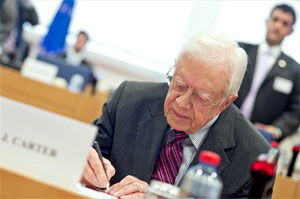How Politicians Shape Truckers (in a Historical Nutshell)
In the beginning…
Traffic laws have existed since 1861, when the Parliament of Britain established the Locomotive on Highways Act to avoid bringing harm to bystanders with industrial road locomotives. At the very start of the 20th century, traffic laws emerged along with the popularity of motor vehicles. Government agencies started requiring vehicle owners to equip license plates to keep drivers accountable.
Traffic lights sprouted like shoots in attempts to maintain order in increasingly busy roads in cities, and owning a vehicle was becoming more of a necessity than a luxury. As motor vehicles became more advanced and affordable – and more commonplace, of course − the freight industry began to find its legs in trucking rather than horse-drawn carriages or trains. Roosevelt’s “New Deal” helped regulate all industries, including our burgeoning trucking industry.
Trucking quickly rose to be one of the primary means of freight transportation in the thirties after the efficiency of trucks were demonstrated in the first world war and a network of roads known as the Interstate Highway System were becoming developed. The roads sprawled out, and so did trucking. By the fifties, trucking became part of history as the most important means of transportation of freight.
The Golden Age
With the spiking demand and increasing fuel prices, President Nixon kicked off the seventies by regulating prices to reduce fuels costs and promote growth in the number of truckers. His plan was followed through by subsequent presidencies – in large part thanks to President Carter − throughout the eighties.
The industry was so impacted that by the nineties the number of truckers in the US had doubled. These golden years through the two decades following Nixon’s plan saw truckers with greater freedom to adjust their own rates and opened the doors on routes they could serve.
Unfortunately, a lack of federal regulations on weight limits and a general concern about the well-being of roads led many states to neglect allowing larger capacity trucks through their borders, effectively creating state-wide road blocks. And since trucking had become less regulated and more accessible, a lack of union control meant decreased pay for truckers in general, which has carried through to this day.
Today’s trucking crisis
The general public’s inattentiveness to the blind spots of commercial trucks has led to a disproportionate number of truck accidents, which continues to spark legal concerns and regulations unfairly against truckers. As an effort to promote safety and take reckless truckers off of the road, it was legislated that truckers have a bare minimum primary liability insurance of $750,000 – though since this number hasn’t changed over the decades, it is now significantly less prohibitive.
The trucking industry now suffers from a deficit of workers numbering at least 130,000 that deepens annually, and is expected to balloon with recent HOS regulations. These laws are intended to prevent fatigue-related trucker accidents. In addition, increasingly strict CDL tests now challenge potential truckers so that only the most focused and aware truckers make the cut.
To answer the call for more truckers, legislators are now starting initiatives to attract more drivers, including one for veteran military truck drivers to waive the CDL test and another to allow formerly illegal immigrants to take it.
How do you think politics will shape trucking in the future?
 Tired of searching for the perfect job? Needing a job with better pay? Let us do the work for you. Fill out our Pre-Qualifying form once, and instantly get matched to companies hiring near you.
Tired of searching for the perfect job? Needing a job with better pay? Let us do the work for you. Fill out our Pre-Qualifying form once, and instantly get matched to companies hiring near you. Truck Drivers Salary varies by driving experience and position held. A CDL Truck Drivers skillset, hauling expertise & endorsements possessed can influence the potential for higher pay. Pay as a CDL Company Driver will differ than that of an Owner Operator, or Team Driver. Currently a Truck Driver can expect to receive a Salary ranging between
Truck Drivers Salary varies by driving experience and position held. A CDL Truck Drivers skillset, hauling expertise & endorsements possessed can influence the potential for higher pay. Pay as a CDL Company Driver will differ than that of an Owner Operator, or Team Driver. Currently a Truck Driver can expect to receive a Salary ranging between